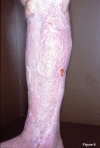Wounds - from physiology to wound dressing
- PMID: 19629204
- PMCID: PMC2696775
- DOI: 10.3238/arztebl.2008.0239
Wounds - from physiology to wound dressing
Abstract
Introduction: Optimal wound management remains the subject of active research. Improved knowledge of physiological wound healing, systemic research into wound dressing and the evaluation of chemical disinfection have given rise to new approaches to wound care.
Methods: Selective literature review.
Results: The primary goals of wound management are rapid wound closure and a functional and aesthetically satisfactory scar. While basic treatment for primary wound healing is often simple, a number of problems can arise in chronic wounds, especially in elderly patients and those with multiple morbidity. It is therefore essential to maintain the basic conditions for physiological wound healing, in particular adequate wound moistness. Each dressing change should entail an evaluation of the wound status, careful cleansing, and treatment tailored to the phase of wound healing. Many therapeutic agents formerly in use are now obsolete. A variety of specific preparations are available for wound covering, including inert, interactive and bioactive substances. There remains a lack of good evidence for these, however.
Conclusions: New findings in molecular and cell biology have improved our understanding of physiological wound healing, and approach to wound care and dressing.
Keywords: chronic wounds; wound care; wound dressing; wound healing.
Figures









Comment in
-
Evidence based guidelines.Dtsch Arztebl Int. 2008 Aug;105(31-32):557; author reply 558. doi: 10.3238/arztebl.2008.0557b. Epub 2008 Aug 4. Dtsch Arztebl Int. 2008. PMID: 19593398 Free PMC article. No abstract available.
-
Requirements too high.Dtsch Arztebl Int. 2008 Aug;105(31-32):557; author reply 558. doi: 10.3238/arztebl.2008.0557d. Epub 2008 Aug 4. Dtsch Arztebl Int. 2008. PMID: 19593399 Free PMC article. No abstract available.
-
Simple remedy.Dtsch Arztebl Int. 2008 Aug;105(31-32):557; author reply 558. doi: 10.3238/arztebl.2008.0557a. Epub 2008 Aug 4. Dtsch Arztebl Int. 2008. PMID: 19593400 Free PMC article. No abstract available.
-
Silver underestimated.Dtsch Arztebl Int. 2008 Aug;105(31-32):557; author reply 558. doi: 10.3238/arztebl.2008.0557c. Epub 2008 Aug 4. Dtsch Arztebl Int. 2008. PMID: 19593401 Free PMC article. No abstract available.
References
-
- Friedrich PL. Das Verhältnis der experimentellen Bakteriologie zur Chirurgie, Antrittsvorlesung 10. Juli 1897. Leipzig: Verlag von Wilhelm Engelmann; 1897.
-
- Lippert H. Wundatlas, Kompendium der komplexen Wundbehandlung. Stuttgart, New York: Thieme Verlag; 2006.
-
- Hofstädter F. Pathologie der Wundheilung. Chirurg. 1995;66:174–181. - PubMed
-
- Singer AJ, Clark RAF. Cutaneous wound healing. N Eng J Med. 1999;341:738–739. - PubMed
-
- Fleischmann W, Russ MK, Moch D. Chirurgische Wundbehandlung. Chirurg. 1998;69:222–232. - PubMed
LinkOut - more resources
Full Text Sources

